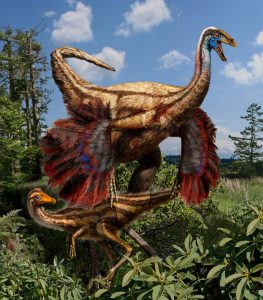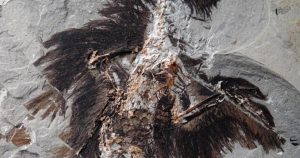
A new breakthrough could enable us to tell what colour dinosaurs were based on their fossils.

Researchers have pinpointed the oldest known example of beta-keratin – a common red-orange pigment – in a 130-million-year-old bird feather fossil.
The fossil of the extinct Eoconfuciusornis bird was collected from the Early Cretaceous lake deposits in Hebei, northern China.

The fossil of the extinct Eoconfuciusornis bird was collected from the Early Cretaceous lake deposits in Hebei, northern China

The study could enable us to tell what colour feathered dinosaurs were. Some researchers believe Tyrannosaurus rex even had feathers (illustrated)

The fossil of the extinct Eoconfuciusornis bird examined in the study was collected from the Early Cretaceous lake deposits in Hebei, northern China
The team applied immunogold – a staining technique used in electron microscopy – to identify proteins.
Their study found fossil evidence of feather structural protein beta-keratin.
‘Multiple independent analyses of both microbodies and associated matrix recovered from the fossil feathers confirm that these microbodies are indeed melanosomes,’ said Dr. Pan Yanhong from Nanjing Institute of Geology and Palaeontology and corresponding author of the research paper.

The findings could open up the possibility of discovering the true colours of other early birds and dinosaurs by examining the structure of their feathers for pigment proteins.
The research was published in the journal Proceedings of the National Academy of Sciences.
If you enjoyed this story or article, make sure to share it with your beloved friends and follow Cat's Voice for more heartwarming content & Videos!


















